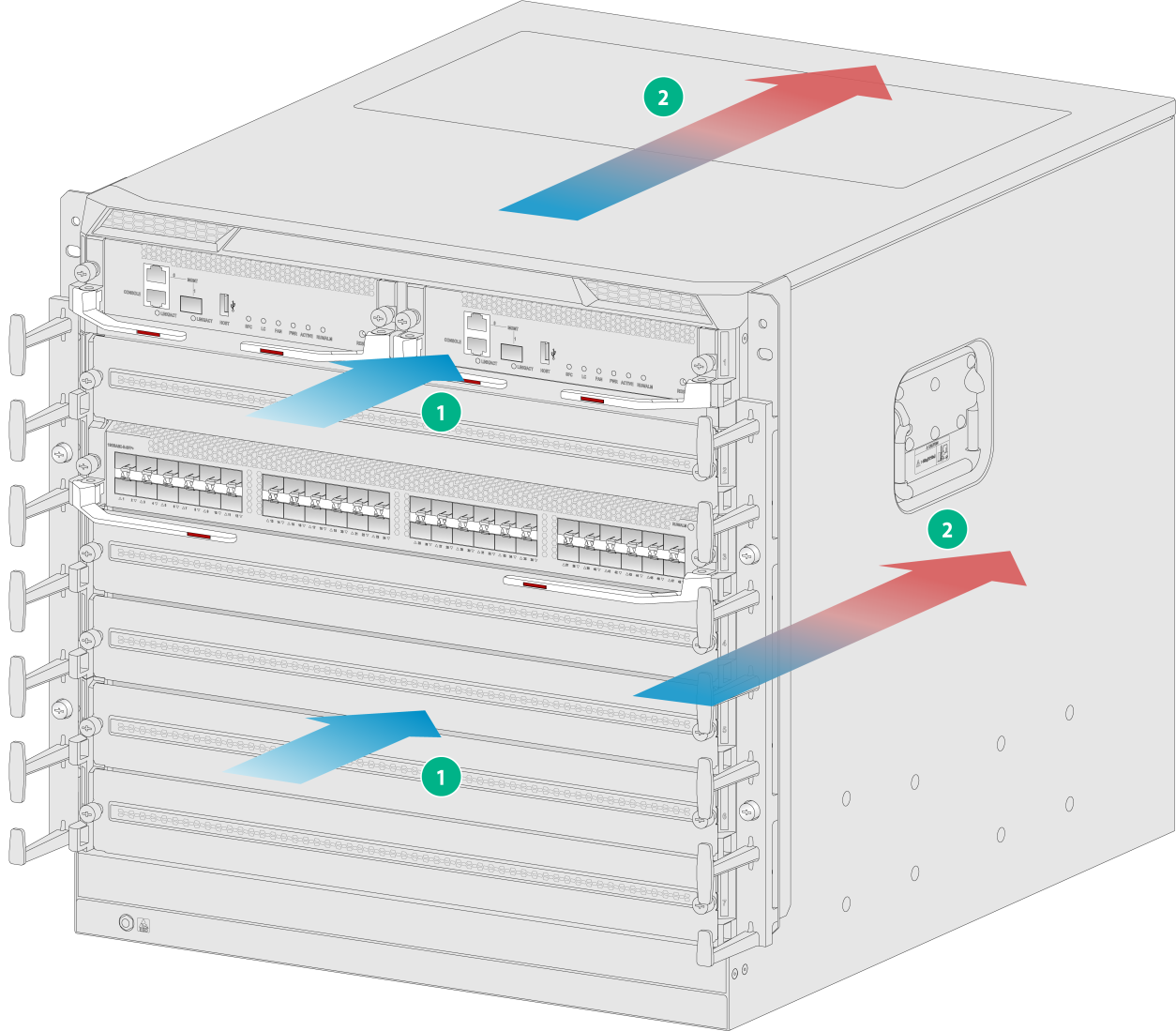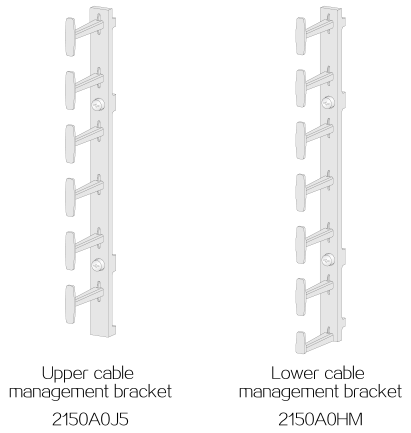- Table of Contents
-
- H3C S10500X-G Switch Series Installation Guide-6W100
- 00-Preface
- 01-Installation Precautions
- 02-Preparing for Installation
- 03-Installing the Switch
- 04-Installing FRUs
- 05-Connecting Your Switch to the Network
- 06-Troubleshooting
- 07-Replacement Procedures
- 08-Appendix A Engineering Labels
- 09-Appendix B Cabling Recommendations
- 10-Appendix C Repackaging the Switch
- Related Documents
-
| Title | Size | Download |
|---|---|---|
| 02-Preparing for Installation | 382.96 KB |
2 Preparing for installation
The S10500X-G switch series has the following models:
· S10506X-G
· S10508X-G
· S10512X-G
Safety recommendations
To avoid possible bodily injury and equipment damage, read Compliance and Safety Manual provided with the switch and all safety recommendations in this chapter carefully before installation. The recommendations do not cover every possible hazardous condition.
General safety recommendations
· Keep the switch clean and dust-free.
· Do not place the switch on a moist area, and avoid liquid flowing into the switch.
· Make sure the ground is dry and flat and anti-slip measures are in place.
· Keep the switch and installation tools away from walk areas.
· Do not wear loose clothing, jewelry (for example, necklace) or any other things that could get caught in the switch when you install and maintain the switch.
Electricity safety
· Clear the work area of possible electricity hazards, such as ungrounded power extension cables, missing safety grounds, and wet floors.
· Locate the emergency power-off switch in the room before installation so you can quickly shut power off when an electrical accident occurs.
· Remove all external cables, including power cords, before moving the chassis.
· Do not work alone when the switch has power.
· Before performing a task that is hazardous when power is present, make sure the switch is completely powered off.
Moving safety
|
WARNING! Do not hold the handle of a fan tray, a power supply, or a module, or the air vents of the chassis to move the switch. Any attempt to move the switch with these parts might cause equipment damage and even bodily injury. |
Remove power supplies, modules, and all external cables, including the power cords, before moving the chassis. As a best practice, use a mechanical lift, such as forklift truck, to move the chassis.
If no mechanical lift is used, follow these guidelines to move the chassis:
· Cooperate with a minimum of two people to move the chassis.
· Lift the chassis by using the chassis handles or by supporting the bottom from the two sides.
· Lift and put down the chassis slowly and never move suddenly.
ESD prevention
To prevent the electric component from being damaged by electrostatic discharge (ESD), follow these guidelines:
· Ground the switch reliably. For how to ground your switch, see "Grounding the switch."
· Always wear an ESD wrist strap and make sure it is reliably grounded when installing field replaceable units (FRUs). For how to use an ESD wrist strap, see "Attaching an ESD wrist strap."
· Hold a module by its edges. Do not touch any electronic components or printed circuit.
· If you are not to use a module, put it in an antistatic bag and keep it secure.
Laser safety
|
WARNING! Disconnected optical fibers or transceiver modules might emit invisible laser light. Do not stare into beams or view directly with optical instruments when the switch is operating. |
Examining the installation site
The switch must be used indoors. To ensure correct operation and long service life of your switch, make sure the installation site meets the following requirements.
Weight support
Make sure the floor or ground at the installation site can support the combined weight of the switch and the rack. The total weight of the switch includes the chassis and its components (for example, modules and power supplies) and accessories. For the weights of the switch and its components, see "Chassis views and technical specifications" in H3C S10500X-G Switch Series Hardware Information and Specifications.
To mount the switch in a rack, select slide rails that can support the total weight of the switch.
To assess the load-bearing requirements for the floor and slide rails, take potential system expansion (for example, adding more modules) also in consideration.
Temperature
|
CAUTION: If condensation appears on the chassis when you move it to a high-temperature environment, dry the chassis before powering it on to avoid short circuits. |
If the temperature in the equipment room is too high, too low, or changes dramatically, the device reliability is reduced and its service lifetime is shortened. For long-term, highly available operation of the device, make sure temperature and humidity in the equipment room meets the requirements described in Table2-1.
Table2-1 Temperature requirements
|
Temperature |
Range |
|
Operating temperature |
0°C to 45°C (32°F to 113°F) |
|
Storage temperature |
–40°C to +70°C (–40°F to +158°F) |
Humidity
Maintain appropriate humidity in your equipment room, as described in Table2-2.
· Lasting high relative humidity can cause poor insulation, electricity leakage, mechanical property change of materials, and metal corrosion.
· Lasting low relative humidity can cause washer contraction and ESD and cause problems including loose mounting screws and circuit failure.
Table2-2 Humidity requirements
|
Humidity |
Range |
|
Operating humidity |
10% to 95%, noncondensing |
|
Storage humidity |
5% to 95%, noncondensing |
Cleanliness
Dust buildup on the chassis might result in electrostatic adsorption, which causes poor contact of metal components and contact points. In the worst case, electrostatic adsorption can cause communication failure.
Table2-1 Dust concentration limits in the equipment room
|
Substance |
Particle diameter |
Concentration limit |
|
Dust particles |
≥ 0.5 µm |
≤ 1.8 × 107 particles/m3 |
Corrosive gases can accelerate corrosion and aging of components. Make sure the corrosive gases in the equipment room do not exceed the concentration limits as shown in Table2-2.
Table2-2 Corrosive gas concentration limits in the equipment room
|
Gas |
Average concentration (mg/m3) |
Maximum concentration (mg/m3) |
|
SO2 |
0.3 |
1.0 |
|
H2S |
0.1 |
0.5 |
|
Cl2 |
0.1 |
0.3 |
|
HCI |
0.1 |
0.5 |
|
HF |
0.01 |
0.03 |
|
NH3 |
1.0 |
3.0 |
|
O3 |
0.05 |
0.1 |
|
NOX |
0.5 |
1.0 |
EMI
All electromagnetic interference (EMI) sources, from outside or inside of the switch and application system, adversely affect the switch in the following ways:
· A conduction pattern of capacitance coupling.
· Inductance coupling.
· Electromagnetic wave radiation.
· Common impedance (including the grounding system) coupling.
To prevent EMI, perform the following tasks:
· If AC power is used, use a single-phase three-wire power receptacle with protection earth (PE) to filter interference from the power grid.
· Keep the switch far away from radio transmitting stations, radar stations, and high-frequency devices.
· Use electromagnetic shielding, for example, shielded interface cables, when necessary.
Grounding
Correctly grounding the switch is crucial to lightning protection, anti-interference, and ESD prevention. Use a good grounding system for the switch. Make sure the resistance between the chassis and the ground is less than 1 ohm.
For more information about grounding the switch, see "Grounding the switch."
Power
Perform the following tasks to meet the power requirements:
1. Calculate the system power consumption.
The system power consumption varies by module types and quantities. For more information about the system power consumption, see "Chassis views and technical specifications" in H3C S10500X-G Switch Series Hardware Information and Specifications.
2. Identify the number of power supplies based on the system power consumption.
The total maximum output power of all power supplies must be greater than the system power consumption. For more information about available power supplies, see "FRUs and compatibility matrixes" in H3C S10500X-G Switch Series Hardware Information and Specifications.
3. Verify that the power system at the installation site meets the requirements of the power supplies, including the input method and rated input voltage. For more information about power supply specifications, see "FRUs and compatibility matrixes" in H3C S10500X-G Switch Series Hardware Information and Specifications.
Cooling
Plan the installation site for adequate ventilation:
· Reserve a minimum clearance of 30 cm (11.81 in) around the inlet and outlet air vents.
· The rack for the switch has a good cooling system.
· The installation site has a good cooling system.
· Verify that the airflow design of the chassis meets the airflow design of the installation site.
Figure2-1 Airflow through an S10506X-G switch
|
(1) Chassis air intake direction |
(2) Chassis air exhaust direction |
Space
For easy installation and maintenance, follow these space requirements:
· Reserve a minimum clearance of 1.2 m (3.94 ft) between the rack and walls or other devices.
· Make sure the rack has enough space to accommodate the switch.
For more information about switch dimensions and rack requirements, see "Switch dimensions and rack requirements."
Installation accessories
Before installation, make sure you have all the required installation accessories.
Table2-3 Installation accessories
|
Product code |
Description |
Quantity |
Applicable device models |
|
2150A0HM |
S10506X-G cable management bracket |
1 pair |
S10506X-G |
|
2150A0J0 |
S10508X-G cable management bracket |
1 pair |
S10508X-G |
|
2150A0J5 2150A0HM |
S10512X-G cable management brackets |
2150A0J5: One pair 2150A0HM: One pair |
S10512X-G |
|
· 26020141 · 26020075 |
M6 screw and cage nut |
· S10506X-G: 10 sets · S10508X-G: 16 sets · S10512X-G: 24 sets |
All S10500X-G models |
|
|
Grounding cable |
1 |
All S10500X-G models |
|
28050001 |
ESD wrist strap |
1 |
All S10500X-G models |
|
· 0221A003 · 0221A004 |
Tweezers for installing and removing transceiver modules |
1 set |
All S10500X-G models |




